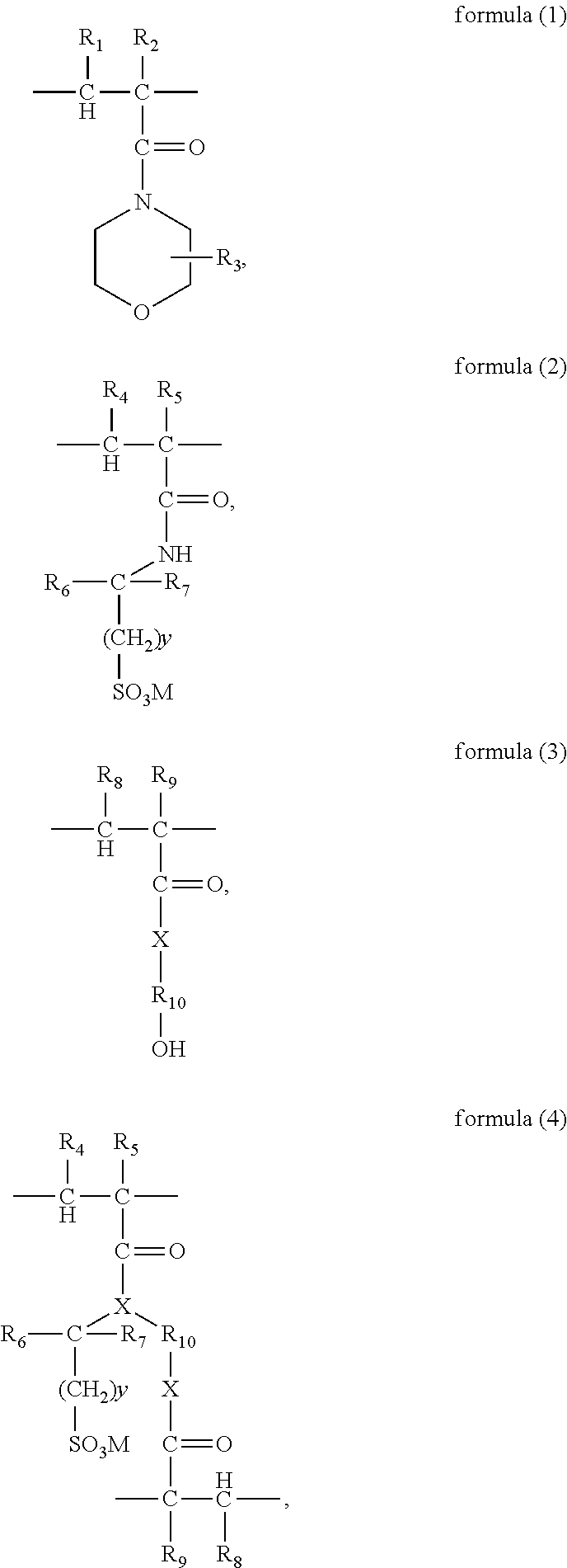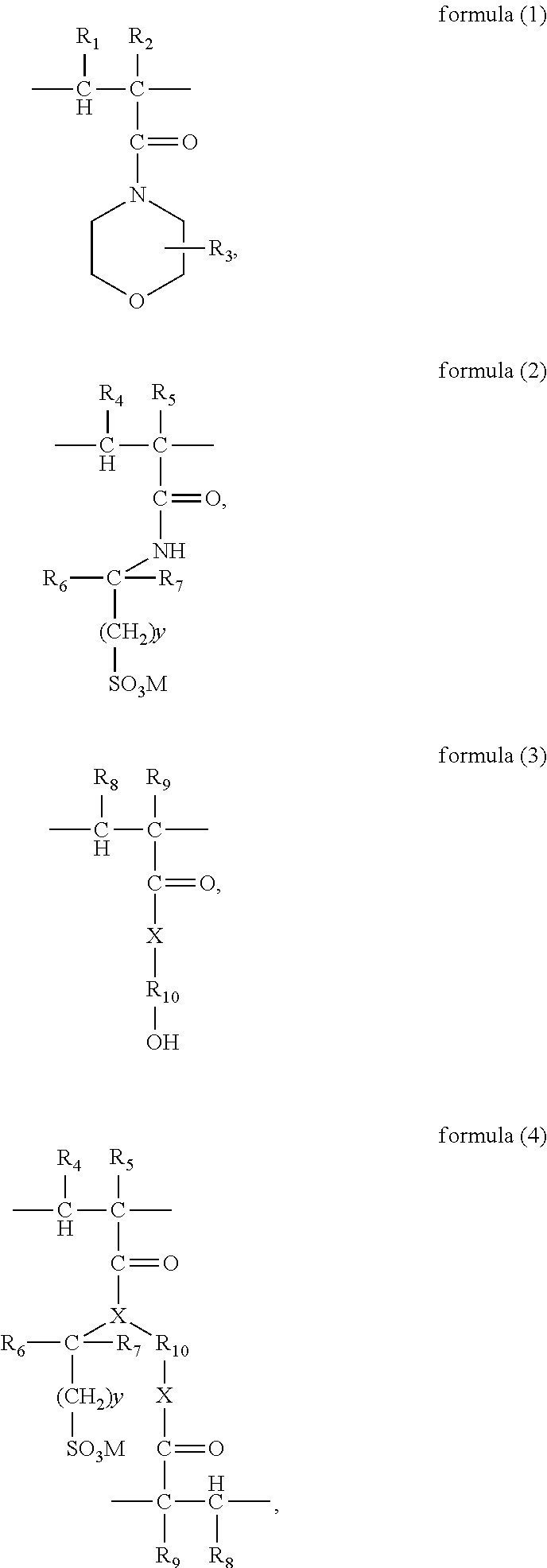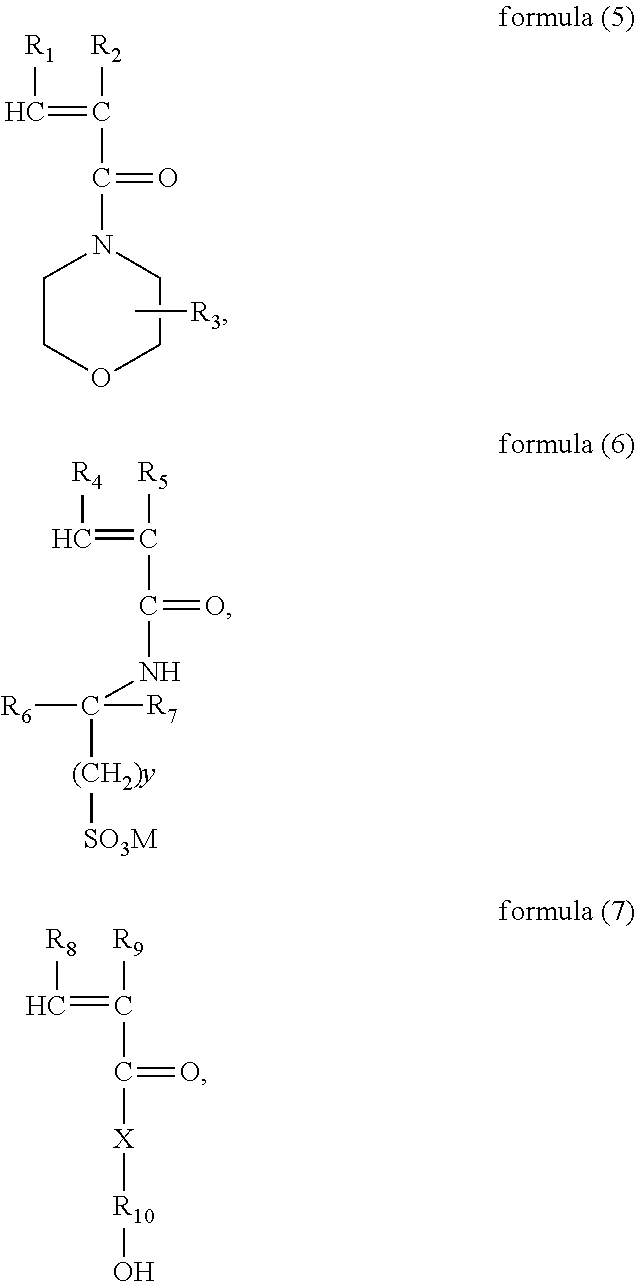Acryloylmorpholine polymer and use thereof and filtrate reducer for drilling fluid
a technology of acryloylmorpholine and filtrate reducer, which is applied in the direction of drilling composition, chemistry apparatus and processes, etc., can solve the problems of increasing the viscosity increasing the requirements the difficulty in controlling the properties of the drilling fluid, etc., to achieve excellent filtrate reduction performance, improve the viscosity, and improve the effect of the polymerization reaction
- Summary
- Abstract
- Description
- Claims
- Application Information
AI Technical Summary
Benefits of technology
Problems solved by technology
Method used
Image
Examples
example 1
[0045]Add 5 mL water into a reaction bulb with an agitator; add 180 g 50% (mass percent) water solution of 2-acrylamide-2-methyl propane sulfonic acid sodium (abbreviated as SAMPS solution) and agitate to homogeneous state; add 6 g N-acryloylmorpholine and 0.2 g N-methylol acrylamide, and agitate till they are dissolved; adjust the pH of the system to 6 with 20% (mass percent) sodium hydroxide solution, to obtain a monomer mixture. Transfer the monomer mixture into a polymerization reactor made of polypropylene plastics; add 0.104 g ammonium persulfate and 0.104 g sodium bisulfite sequentially while agitating; static react for 15 min at room temperature 30° C. after agitating homogeneously, to obtain a viscous product. The apparent viscosity of 1 wt. % water solution of the viscous product is 7.5 mPa·s. Then, control the viscous product to constant temperature react for 2 h at 100° C., to obtain a gelatinous elastic cross-linked polymer. Shear, dry and crush the obtained gelatinous ...
example 2
[0046]Add 10 mL water into a reaction bulb with an agitator; add 180 g 50% (mass percent) water solution of 2-acrylamide-2-methyl propane sulfonic acid sodium and agitate to homogeneous state; add 25.5 g N-acryloylmorpholine and 0.3 g N-methylol acrylamide and agitate till they are dissolved; adjust the pH of the system to 7 with 20% (mass percent) sodium hydroxide solution, to obtain a monomer mixture. Transfer the monomer mixture into a polymerization reactor made of polypropylene plastics; add 0.3 g potassium persulfate and 0.3 g sodium pyrosulfite sequentially while agitating; static react for 25 min at room temperature 60° C. after agitating homogeneously, to obtain a viscous product. The apparent viscosity of 1 wt. % water solution of the viscous product is 6.5 mPa·s. Then, control the viscous product to constant temperature react for 3 h at 95° C., to obtain a gelatinous elastic cross-linked polymer. Shear, dry and crush the obtained gelatinous elastic cross-linked polymer, t...
example 3
[0047]Add 30 mL water into a reaction bulb with an agitator; add 180 g 50% (mass percent) water solution of 2-acrylamide-2-methyl propane sulfonic acid sodium and agitate to homogeneous state; add 42 g N-acryloylmorpholine and 0.4 g N-methylol acrylamide and agitate till they are dissolved; adjust the pH of the system to 7.5 with 20% (mass percent) sodium hydroxide solution, to obtain a monomer mixture. Transfer the monomer mixture into a polymerization reactor made of polypropylene plastics; add 0.4 g potassium persulfate and 0.4 g sodium sulfite sequentially while agitating; static react for 25 min at room temperature 40° C. after agitating homogeneously, to obtain a viscous product. The apparent viscosity of 1 wt. % water solution of the viscous product is 6.25 mPa·s. Then, control the viscous product to constant temperature react for 3.5 h at 95° C., to obtain a gelatinous elastic cross-linked polymer. Shear, dry and crush the obtained gelatinous elastic cross-linked polymer, to...
PUM
| Property | Measurement | Unit |
|---|---|---|
| apparent viscosity | aaaaa | aaaaa |
| wt. % | aaaaa | aaaaa |
| reaction temperature | aaaaa | aaaaa |
Abstract
Description
Claims
Application Information
 Login to View More
Login to View More - R&D
- Intellectual Property
- Life Sciences
- Materials
- Tech Scout
- Unparalleled Data Quality
- Higher Quality Content
- 60% Fewer Hallucinations
Browse by: Latest US Patents, China's latest patents, Technical Efficacy Thesaurus, Application Domain, Technology Topic, Popular Technical Reports.
© 2025 PatSnap. All rights reserved.Legal|Privacy policy|Modern Slavery Act Transparency Statement|Sitemap|About US| Contact US: help@patsnap.com



